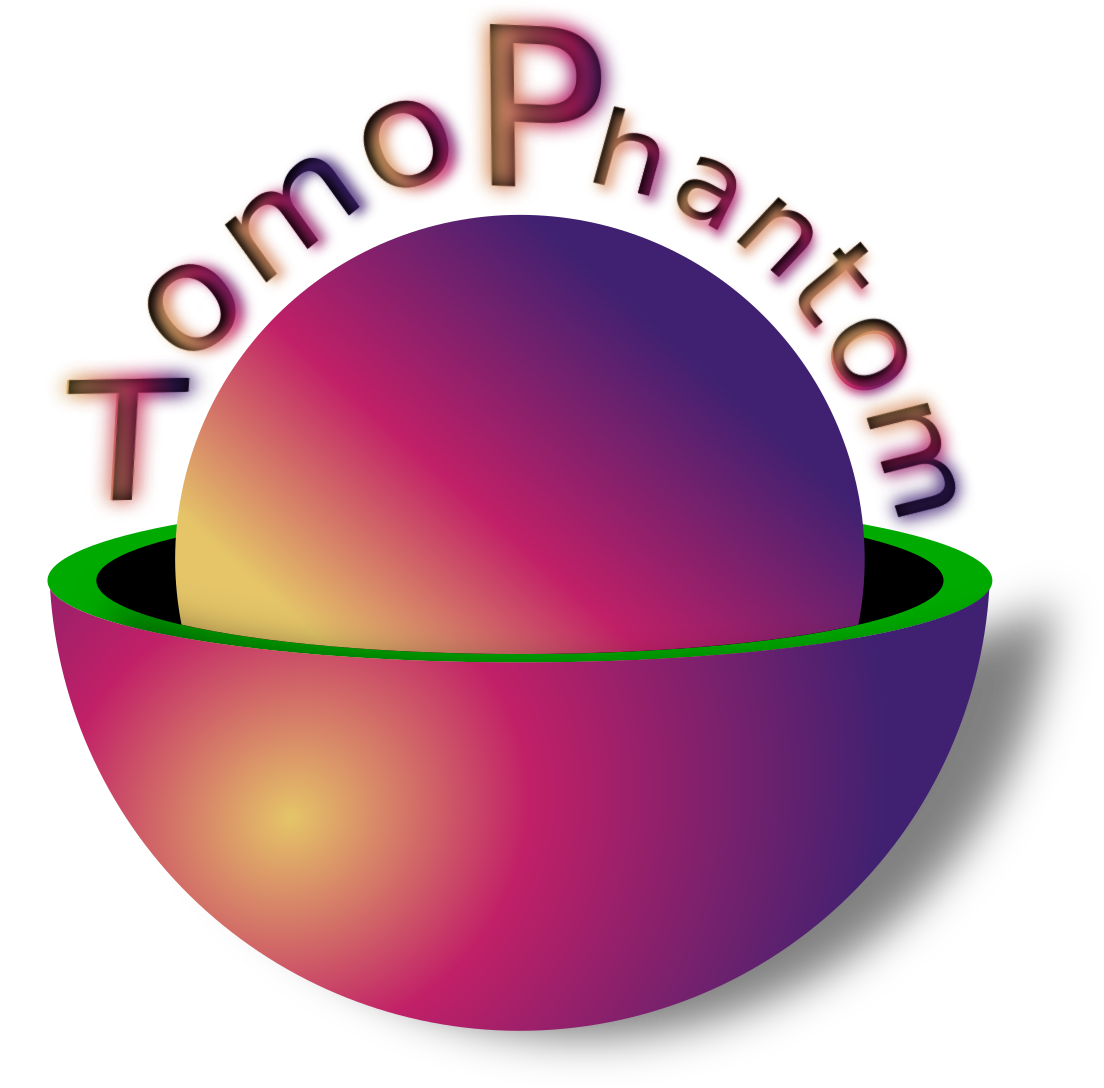tomophantom.artefacts#
Modules to generate different imaging artefacts.
- tomophantom.artefacts.artefacts_mix(data: <np.ndarray>, **artefacts_dict: ~typing.Any) <np.ndarray> | list[source]#
- A module to generate and apply a mix of various typical imaging artefacts to add to the simulated data.
One can build various dictionaries with keywords arguments specified bellow and pass it to the function as: artefacts_mix(data, **noise_dict, **zingers, **etc).
DISCLAIMER: Note that most of the features are experimental and do not always reflect the accurate modelling of the real imaging artefacts.
- Parameters:
data (3D projection) – 2D or 3D numpy array (sinogram or 3D projection data).
shape (The input data must be of the following) – 2D sinogram (anglesDim, DetectorsHoriz),
data
**artefacts_dict (dict) – A dictionary with keyword arguments related to different artefact type.
- Keyword Arguments:
noise_type (str) – Define noise type as ‘Poisson’ or ‘Gaussian’.
noise_amplitude (int, float) – Photon flux for Poisson or variance for Gaussian noise.
noise_seed (int) – Seeds for noise generator. ‘None’ defines random generation.
noise_prelog (bool) – Set to True if pre-log (raw) data required.
zingers_percentage (float) – The amount of zingers (dead pixels, outliers) to be added to the data.
zingers_modulus (int) – Modulus to control the amount of 4/6 pixel clusters to be added.
stripes_percentage (float) – The amount of stripes in the data (rings in reconstruction).
stripes_maxthickness (int) – Maxthickness defines the maximal thickness of a stripe.
stripes_intensity (float) – Controls the intensity levels of stripes.
stripe_type (str) – Stripe types can be ‘partial’ or ‘full’.
stripes_variability (float) – Variability multiplier to incorporate the change of intensity in stripe.
datashifts_maxamplitude_pixel (int) – Controls pixel-wise (integer) misalignment in data.
datashifts_maxamplitude_subpixel (float) – Controls subpixel misalignment in data.
pve_strength (int) – The strength of partial volume effect, responsible for the limited resolution of a scanner.
fresnel_dist_observation (int) – The distance for observation for fresnel propagator.
fresnel_scale_factor (float) – Fresnel propagator scaling.
fresnel_wavelenght (float) – Fresnel propagator wavelength.
verbose (bool) – Make the output of modules verbose.
- Returns:
2D/3D numpy array with artefacts applied to input data. [np.ndarray, shifts]: a list of 2D/3D numpy array and simulated shifts.
- Return type:
np.ndarray
- tomophantom.artefacts.datashifts(data: <np.ndarray>, maxamplitude: int) list[source]#
Function to add random pixel shifts to 3D or 3D data as an offset for each angular position.
- Parameters:
data (3D projection) – 2D sinogram or 3D projection data. The input data must be of the following shape: 2D sinogram (anglesDim, DetectorsHoriz),
data
maxamplitude (int) – The misilighnment ammplitude. Defines the maximal amplitude of each shift in pixels.
- Returns:
2D or 3d data with misalignment and shifts vectors [data, shifts].
- Return type:
list
- tomophantom.artefacts.datashifts_subpixel(data: <np.ndarray>, maxamplitude: float) list[source]#
Function to add random sub-pixel shifts to 3D or 3D data as an offset for each angular position.
- Parameters:
data (3D projection) – 2D sinogram or 3D projection data. The input data must be of the following shape: 2D sinogram (anglesDim, DetectorsHoriz),
data
maxamplitude (float) – The misilighnment ammplitude. Defines the maximal amplitude of each shift.
- Returns:
2D or 3d data with misalignment and shifts vectors [data, shifts].
- Return type:
list
- tomophantom.artefacts.fresnel_propagator(data: <np.ndarray>, dist_observation: int, scale_factor: float, wavelenght: float) <np.ndarray>[source]#
- Fresnel propagator applied to data.
Adapted from the script by Adrián Carbajal-Domínguez, adrian.carbajal@ujat.mx
- Parameters:
data (3D projection) – 2D sinogram or 3D projection data. The input data must be of the following shape: 2D sinogram (anglesDim, DetectorsHoriz),
data
dist_observation (int) – The distance for obervation for fresnel propagator.
scale_factor (float) – Scaling.
wavelenght (float) – Wavelength.
- Returns:
2D or 3D data with propagation.
- Return type:
np.ndarray
- tomophantom.artefacts.noise(data: <np.ndarray>, sigma: int | float, noisetype: str, seed: bool = True, prelog: bool = False) list | <np.ndarray>[source]#
Adding random noise to data (adapted from LD-CT simulator)
- Parameters:
data (np.ndarray) – N-d array
sigma (Union[int, float]) – int for Poisson or float for Gaussian
noisetype (str) – ‘Gaussian’ or ‘Poisson’
seed (bool, optional) – Initiate random seed with True. Defaults to True.
prelog (bool, optional) – get raw data if true, returns a list [noisy, raw]!. Defaults to False.
- Returns:
N-d array
- Return type:
np.ndarray
- tomophantom.artefacts.pve(data: <np.ndarray>, pve_strength: int) <np.ndarray>[source]#
Applying Partial Volume effect (smoothing) to data.
- Parameters:
data (3D projection) – 2D sinogram or 3D projection data. The input data must be of the following shape: 2D sinogram (anglesDim, DetectorsHoriz),
data
pve_strength (int) – The level of smoothing, defined by kernel size.
- Raises:
ValueError – Smoothing kernel must be positive
- Returns:
Smoothed 2D or 3D data.
- Return type:
np.ndarray
- tomophantom.artefacts.stripes(data: <np.ndarray>, percentage: float, maxthickness: int, intensity_thresh: float, stripe_type: str, variability: float) <np.ndarray>[source]#
Function to add stripes (constant offsets) to sinograms or 3D projection data which results in rings in the reconstructed image.
- Parameters:
data (np.ndarray) – 2D sinogram (anglesDim, DetectorsHoriz) or 3D projection data (DetectorsVert, anglesDim, DetectorsHoriz).
percentage (float) – Percentage defines the amount of stripes in the data.
maxthickness (int) – Defines the maximal thickness of a stripe.
intensity_thresh (float) – Controls the intensity levels of stripes.
stripe_type (str) – Choose between ‘partial’ or ‘full’.
variability (float) – Variability multiplier to incorporate change of intensity in the stripe.
- Raises:
ValueError – Percentage is out of range.
ValueError – Thickness is out of range.
- Returns:
2D sinogram or 3D projection data with stripes
- Return type:
np.ndarray
- tomophantom.artefacts.zingers(data: <np.ndarray>, percentage: float, modulus: int) <np.ndarray>[source]#
- Adding zingers (zero single pixels or small 4 pixels clusters)
to sinograms or 6 voxels to 3D projection data.
- Parameters:
data (3D projection) – 2D sinogram or 3D projection data. The input data must be of the following shape: 2D sinogram (anglesDim, DetectorsHoriz),
data
percentage (float) – The amount of zingers to be added to the data.
modulus (int) – Modulus to control the amount of 4/6 pixel clusters to be added.
- Raises:
ValueError – Percentage is out of range.
ValueError – Modulus must be positive.
- Returns:
2D or 3D array with zingers.
- Return type:
np.ndarray

